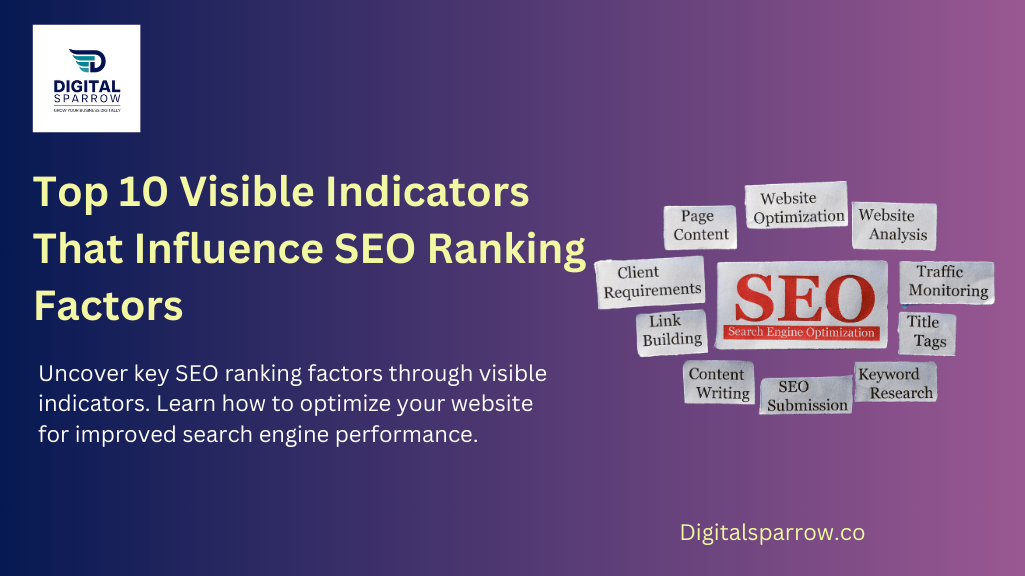In the ever-evolving world of search engine optimisation (SEO), staying on top of the latest trends and best practises is crucial for maintaining and improving your website’s visibility in search engine results pages (SERPs). SEO is a complex field with numerous factors that influence your website’s ranking, some of which are more visible and tangible than others. In this article, we will explore the top 10 visible indicators that can significantly impact your SEO ranking factors.
1. Keyword Optimisation
Keywords are the backbone of SEO. Optimising your content with relevant keywords is a highly visible indicator of SEO success. Use tools like Google’s Keyword Planner to research and select keywords that align with your content and audience. A fundamental aspect of SEO involves strategically selecting and incorporating relevant keywords into online content to improve search engine rankings. It begins with in-depth keyword research to identify phrases and terms users are likely to use when searching for information related to your website’s topic or industry.
Effective keyword optimisation entails the natural and prudent placement of these keywords in critical sections like titles, headers, body text, and meta tags. However, it’s critical to strike a balance by avoiding keyword stuffing, which might result in search engine penalties.
In today’s SEO, user intent and content quality are equally important. Content should provide value and satisfy the needs of the user, with keywords enhancing rather than harming the user experience. Regularly updating and refining keyword strategies based on shifting search patterns is critical for long-term SEO performance. Proper keyword optimisation helps websites rank better in search results, improving their visibility to the proper audience.
2. High-Quality Content
High-quality content refers to material that exhibits superior standards in terms of relevance, accuracy, and value. It caters to its intended audience by delivering well-researched, informative, and engaging information. Such content is meticulously crafted, free from errors, and thoughtfully structured, ensuring clarity and coherence.
High-quality content also adheres to ethical norms, avoiding plagiarism and misinformation. It has a distinct and original viewpoint, providing new insights or viewpoints on a subject. Furthermore, it frequently combines multimedia components, such as photographs, videos, or infographics, to improve comprehension and engagement.
Finally, high-quality content attempts to accomplish its goal, whether it’s teaching, entertaining, or persuading, while leaving a pleasant impression on the reader or viewer. It not only draws and retains an audience, but it also fosters trust and authority in the subject or industry in question.
3. User-Friendly URLs
User-friendly URLs, also known as clean URLs or readable URLs, are web addresses designed for simplicity and ease of use. They enhance the user experience by conveying meaningful information about the content or page they link to. These URLs typically feature descriptive words and phrases related to the page’s topic, making them more intuitive and memorable for visitors.
User-friendly URLs are short, free of obscure characters or strings of numbers, and avoid the excessive use of special characters. They improve search engine optimisation (SEO) by giving search engines useful context about the page’s content. Furthermore, they contribute to better accessibility for people with impairments and assist users in swiftly determining the relevancy of a page before clicking on it. To summarise, user-friendly URLs are critical for optimising website navigation and overall user satisfaction.
- 4. Mobile Optimisation
Mobile optimisation is the process of ensuring that websites, applications, and content are designed and configured to perform efficiently and provide an excellent user experience on mobile devices, such as smartphones and tablets. It involves responsive web design, where layouts and elements adapt seamlessly to different screen sizes and resolutions, ensuring readability and usability.
Mobile optimisation also prioritises rapid loading speeds, as mobile consumers have little patience for pages that take a long time to load. This includes picture optimisation and removing extraneous scripts and code. It also emphasises touch-friendly interfaces, user-friendly navigation, and simplified information for smaller screens. Mobile optimisation is crucial in today’s mobile-centric world for businesses and content providers to efficiently reach and engage their audience, enhance search engine results, and create a seamless experience across all devices.
What Are The Different Types Of Online Ads?
- 5. Page Loading Speed
Page loading speed refers to the time it takes for a web page to fully display its content in a user’s browser after they click a link or enter a URL. It is a crucial factor in determining the user experience and the success of a website. Faster loading times are generally associated with a more positive user experience, while slow-loading pages can lead to frustration and high bounce rates.
Server performance, the amount and complexity of web page elements (such as graphics, scripts, and stylesheets), and code efficiency are all factors that influence page loading time. Web developers frequently utilise techniques such as image compression, code minification, content caching, and the usage of content delivery networks (CDNs) to optimise page loading time.
Page loading speed is also a ranking criteria for search engines; therefore, faster-loading pages can contribute to enhanced SEO performance and increased visibility in search results. In conclusion, page loading speed is an important part of online performance that has a direct impact on user pleasure, SEO, and overall website success.

- 6. Internal Linking
Internal linking is a website optimisation strategy that involves creating hyperlinks within a website’s content to connect one page to another within the same domain. These links serve several purposes, such as improving navigation and user experience by guiding visitors to related or relevant content. Internal linking also helps search engines understand the structure and content hierarchy of a website, which can improve SEO. Internal linking can increase the authority and exposure of specific pages by distributing link equity and directing traffic to essential pages. It’s a critical approach for improving website usability, improving SEO, and ensuring users find valuable content quickly.
- 7. Meta Titles and Descriptions
Meta titles and descriptions are HTML elements that provide concise summaries of web page content to search engines and users. The meta title, displayed in search results and browser tabs, summarises a page’s topic, while the meta description offers a brief description. These factors must be optimised for SEO because they affect click-through rates (CTR) and search engine rankings. Effective meta titles and descriptions are informative, interesting, and include relevant keywords to capture visitors’ attention while also providing context about the page’s content. Writing engaging meta titles and descriptions is critical for increasing a website’s visibility, user engagement, and overall search performance.
- 8. Header Tags (H1, H2, H3, etc.)
Header tags, denoted as H1, H2, H3, and so on in HTML, play a crucial role in structuring web content. These tags define the hierarchy and importance of different sections of a web page. The H1 tag typically represents the main heading or title of the page, while H2, H3, and so forth are used to organise subheadings and content under each section.
Header tags have several roles. They improve readability and the user experience by providing a clear and organised structure to the text. Search engines employ header tags to comprehend the structure and context of content, allowing them to index and rank pages appropriately. Properly employing header tags with relevant keywords can improve a page’s visibility in search results.
Header tags are important for both user experience and SEO since they help with content organisation, clarity, and search engine optimisation.
- 9. Image Optimisation
Image optimisation is the process of enhancing and compressing images to improve website performance and user experience. It involves reducing image file sizes without compromising quality, which leads to faster page loading times. This is achieved through techniques like compression and format selection. Properly optimised images also include descriptive filenames and alt text for accessibility and SEO benefits. By reducing bandwidth usage and ensuring images load quickly, image optimisation contributes to a smoother, more efficient web browsing experience, which can lead to higher user engagement, improved search engine rankings, and decreased bounce rates on websites.
- 10. Schema Markup
Schema markup, also known as structured data markup, is a type of code added to web pages to provide search engines with detailed information about the content on the page. It uses a standardised vocabulary of tags to mark up elements like events, products, reviews, and more, helping search engines understand and categorise the content.
Schema markup improves search engine results by providing rich snippets, knowledge panels, and other rich elements that appear in search results. This can result in higher click-through rates and increased visibility in search results.
Furthermore, schema markup is critical for voice search and future technologies like augmented reality because it allows robots to interpret and present information in a more meaningful way.
Overall, implementing schema markup is a valuable SEO strategy that can enhance a website’s visibility, user experience, and engagement.
Social media marketing for startups – A 30 days plan
Conclusion
While SEO encompasses a wide range of factors, these ten visible indicators play a crucial role in determining your website’s search engine rankings. By paying attention to keyword optimisation, content quality, user experience, and other visible aspects of SEO, you can enhance your website’s visibility and attract more organic traffic. Remember that SEO is an ongoing process, and staying up-to-date with best practises is essential for long-term success in the digital landscape.


Your article helped me a lot, is there any more related content? Thanks!
Your article helped me a lot, is there any more related content? Thanks!
作為時尚界的經典品牌,Celine 在高端手袋與配飾領域中占有重要地位。celine哪裡買最便宜
DW(Daniel Wellington)手錶,以其簡約而不失精致的設計、卓越的品質以及親民的價格,成為了許多人的心頭好。dw 手錶哪裡買最便宜?
旅行伴侶rimowa 行李箱
電子煙:健康之選,臺灣新風尚 一次性小煙
時尚舒適並重:探索Nike Air Max 90的獨特魅力 air max推薦